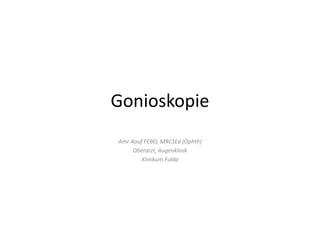
Gonioskopie.pptx
- 1. Gonioskopie Amr Aouf FEBO, MRCSEd (Ophth) Oberarzt, Augenklinik Klinikum Fulda
- 2. Geschichte Alexios Trantas 1899- Griechenland: Erster KW gesehen in Keratoglobuspatient + Druck am Limbus Maximilian Salzmann 1914 – Österreich : Erstes Gonioglas entwickelt (KL) Leonhard Köppe 1919-Deutschland: nur für temporale und nasale KW- Untersuchung (mit Medium)
- 3. Otto Barkan 1936- USA Köppe Linse + Illuminator View durch angehängte Spaltlampe. Manuel Uribe y Troncoso 1925- Mexico: erstes illuminiertes Gonioglas
- 4. Hans Goldmann 1938- Bohemia (Tschechische Republik): Spaltlampe Tonometer Perimeter 3-Spiegel Kontaktlinse Allen-Thorpe Gonioprism: kein Kontaktmedium notwendig Lee Allen (1-Spiegel), Harvey Thorpe (4-Spiegelvariante) 1941-USA
- 5. Prinzip Lichtstrahlen, die aus dem Winkel der Vorderkammer kommen, überschreiten den Grenzwinkel (KW-Luft = 40°) und werden daher in die VK zurückreflektiert. Größerer Brechungsindex Weniger Brechungsindex
- 6. Sorten Direkt indirekt Koeppe Layden Richardson-shaffer Swan Jacop Hoskins Barkan Allen-Thorpe Goldmann (1 Spiegel, 3- Spiegel)
- 7. Indirekt… • Sussman 4-Mirror : kein Medium + Indentation = Volk G4, G6 • Posner : 4 Spiegel + Halterung = Zeiss 4-Mirror • Ritch trabeculoplasty lens …für SLT, ALT
- 8. Anatomie
- 9. -> Breiter Ziliarkörper in: Myopen und Aphakie, pathologisch breit in Zyklodialyse . -> Schmaler Ziliarkörper in Hyperopie und ant. Irisinsertion
- 10. Methode • Vorab nur Anästhetikum, kein Pilo ! • Belechtung senkrecht oder off-center at 30–35º. Der Spaltlampenstrahl sollte die geringstmögliche Beleuchtung und Vergrößerung haben (2 mm breit). • Beginnend im temporalen Quadrant, nicht in den Pupillenbereich fallen und parallel zur Spiegelachse (vertikal für den oberen und unteren Winkel und horizontal für den nasalen und temp. Winkel). Oder vert. nur ein Teil der Iris beleuchten.
- 11. Lichtstrahl 10-15° shräg halten!.
- 13. Dynamische Gonioskopie • 1- Indentation • 2- Over The Hill
- 16. • Over The Hill Gonioscopy:
- 18. Grading: Shaffer System Robert N. Shaffer USA, (1912 – 2007)
- 19. Grading: Scheie System Harold G. Scheie USA, 1909-1990
- 20. Grading: Spaeth System George L. Spaeth USA, geb. 1932
- 21. Das neuere System beschreibt vier Iriskonfigurationen: • b = „Bögen 1 bis 4 plus“ (ein Hinweis auf einen erscheinenden KW-Verschluss, der sich mit Eindellung eröffnet) • p = ‘p lateau’ (vergleichbar mit älterer ‘s’-Bezeichnung) • f = „flacher Ansatz“: die häufigste Irisform (vergleichbar mit der älteren „r“-Bezeichnung) • c = „concave“ wie bei nach hinten gebogener Iris (vergleichbar mit der älteren „q“-Bezeichnung).
- 23. Befunddokumentation “Schriftlich” • Beispiel nach Spaeth: E40c, 4+ TMP = Eine extrem tief inserierte Iriswurzel, in einem 40°-Winkel-Recess, mit hinterer Irisverwölbung und ausgedehntem TMP (zB. bei myopen Augen mit Pigmentdispersionssyndrom). • Wie ist der Grad in Slide 14 nach Spaeth? • Antwort: Spaeth = (A)20b3+
- 26. Befundanalyse
- 27. Andere Fälle… Sampaolesi line (PEX) PAS RI
- 29. Blut im Schlemmkanal Double Hump Sign Plateau Iris
- 33. Weiterlesen….
- 34. Vielen Dank
